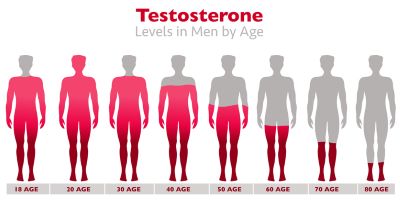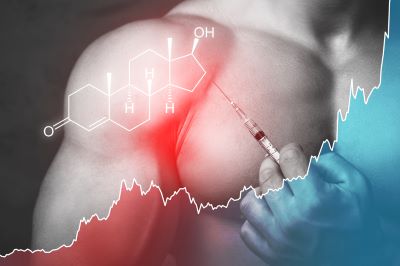Andropause is a series of emotional and physical health problems experienced by men caused by age-related hormone decline.
Men go through a similar condition to menopause in women, known as “andropause.” Just as in women, the condition is caused by age-related hormone loss. While the loss of other hormones such as human growth hormone can contribute to andropause, the primary cause of andropause in men is age-related testosterone decline.
In fact, the symptoms of “andropause” are so contingent on your testosterone level that you will often see the terms “andropause” and “low testosterone” used interchangeably to describe the symptoms of age-related testosterone deficiency, also known as “hypogonadism.”
Why Is Testosterone Considered a Vital Male Hormone?
 Testosterone is the most important male hormone or androgen. Testosterone is produced by the testes. Testosterone production and release starts in the womb. As a male child grows, testosterone production increases, and at puberty is responsible for all of the changes that allow a boy to become a man, including maturation of the sex organs and all of the “secondary” male characteristics such as facial hair, deeper voice, etc.
Testosterone is the most important male hormone or androgen. Testosterone is produced by the testes. Testosterone production and release starts in the womb. As a male child grows, testosterone production increases, and at puberty is responsible for all of the changes that allow a boy to become a man, including maturation of the sex organs and all of the “secondary” male characteristics such as facial hair, deeper voice, etc.
Even after puberty, testosterone continues to play a vital role in a man’s health. Testosterone helps build lean muscle and strong bones. It is essential for good sexual performance, and it plays a vital role in sleep, cognition, metabolism, and many other areas of health and vitality.
But for all of its importance, unfortunately, your level of testosterone dwindles as you age. Testosterone levels peak at about the age of 20; after that, they start a steady decline. By the time a man is over 40, he could already begin to experience some of the symptoms of andropause or low testosterone.
What Are the Normal Testosterone Levels for Men by Age?
The amount of testosterone your body makes varies as you age.
Testosterone levels are measured in nanograms per deciliter (ng/dl). What is considered a normal testosterone level varies by age. The following charts indicate the normal testosterone levels for men at different stages of life.
Infants and children
| Age | Male (in ng/dl) | |
| 0 to 5 months | 75-400 | |
| 6 months to 9 years | Less than 7-20 | |
| 10 to 11 years | Less than 7-130 |
Adolescents
| Age | Male (in ng/dl) | |
| 12 to 13 years | Less than 7-800 | |
| 14 years | Less than 7-1,200 | |
| 15 to 16 years | 100-1,200 |
Adults
| Age | Male (in ng/dl) | |
| 17 to 18 years | 300-1,200 | |
| 19 years and older | 240-950 |
What Is Andropause?
Andropause is a collection of negative physical and emotional health issues caused primality by low testosterone. Low testosterone affects almost 40% of men aged 45 and older.
Unlike menopause in women, which occurs at a specific point in time — after her last menstrual period — andropause in men occurs more slowly over time. Menopause in women is caused mainly by the depletion of estrogen. Andropause is caused by the slow decrease in testosterone that occurs as a man ages.
Decreasing levels of human growth hormone also contribute to andropause; however, its driving force is age-related testosterone decline. Testosterone is the most important androgen or male hormone.
Testosterone levels peak in men at around the age of 20. After that, the testosterone level in the blood slowly drops. By the time a man is in his 60s, his testosterone level could be HALF of what it was in his 20s!
How Is Andropause or Male Menopause Treated?
 The only clinically proven treatment for andropause is hormone replacement therapy. Testosterone replacement therapy is the main treatment given for men suffering from andropause, but depending on your symptoms and lab tests, your doctor may also recommend growth hormone therapy.
The only clinically proven treatment for andropause is hormone replacement therapy. Testosterone replacement therapy is the main treatment given for men suffering from andropause, but depending on your symptoms and lab tests, your doctor may also recommend growth hormone therapy.
There are several forms of testosterone treatments. Low testosterone treatment can be given as topical gels and creams, subdermal pellets, skin patches, or testosterone injections. Our doctors have found testosterone injections to be the safest and most effective type of low testosterone treatment.
Testosterone injections are prescribed as different “esters.” Each “ester” is simply a different chemical form of testosterone. They differ only in their molecular structure. The most commonly prescribed ester used for the treatment of low testosterone is testosterone cypionate.
The before and after results of testosterone replacement therapy for the treatment of andropause have been well documented and can be life-changing for men diagnosed with low testosterone.
Conclusion
Andropause is a very real medical condition largely caused by age-related testosterone loss. Testosterone replacement therapy has been clinically proven to reverse or minimize all of the negative health issues associated with andropause.
 A recent landmark collective study known as the “Testosterone Trials” was conducted in collaboration with a dozen well-respected medical centers nationwide and the National Institute on Aging to determine the value of testosterone replacement therapy for aging men experiencing the symptoms of andropause.
A recent landmark collective study known as the “Testosterone Trials” was conducted in collaboration with a dozen well-respected medical centers nationwide and the National Institute on Aging to determine the value of testosterone replacement therapy for aging men experiencing the symptoms of andropause.
The TTrials were a coordinated set of seven placebo-controlled, double-blind trials in 788 men with a mean age of 72 years, designed to determine the efficacy of increasing the testosterone levels of older men with low testosterone through the use of testosterone replacement therapies.
The findings of the Testosterone Trials were published in March of 2018. The key takeaways from the TTrials were that for men suffering from andropause, testosterone treatment for one year:
- Improved all aspects of sexual function
- Improved strength and mobility
- Improved mood and depressive symptoms
- Markedly increased bone mineral density and estimated bone strength.
Frequently Asked Questions About Testosterone and Andropause
At what age does men’s testosterone drop?
A man’s testosterone level peaks at about the age of 20. After that, testosterone level starts a steady drop of about 1% to 2% per year. Most men between the ages of 40 and 65 will feel the effects of low testosterone to one degree or another.
How do you test for andropause?
Only your medical doctor can make a diagnosis of andropause or low testosterone. To do that, he or she will first take a medical history and do a complete physical exam to rule out any other cause for your symptoms of andropause; then, your testosterone level will be checked using a simple blood test.
How do I know if my testosterone levels are low?
Testosterone levels are determined via a simple blood test. Testosterone levels do fluctuate throughout the day, so your testosterone blood test will probably be done first thing in the morning. If your testosterone levels are determined to be low for your weight and age, and if an evaluation of your presenting symptoms warrants it, you will be prescribed testosterone therapy.

